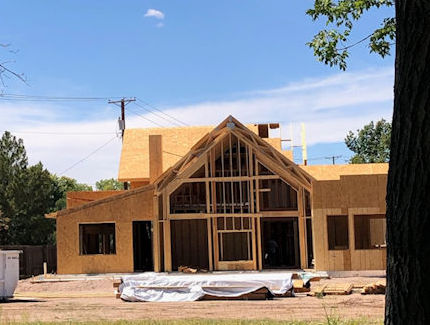Southwest & Albuquerque: Glossary of Architectural Home Styles & Building Terms
Want to know the difference between a viga and a latilla? How about the difference between Northern New Mexico style and Pueblo style? Let our glossary of Southwestern architectural styles and materials help you come to terms with regional design and building techniques in our beautiful Land of Enchantment state.
Architectural Home Styles
Tuscan / Mediterranean style: These styles, influenced by the areas from which they are named, became extremely popular from 1918 to 1940. Modeled after the hacienda style, this style home features plaster surfaces, arches and red barrel tile roofs as well as balconies, porticos and ornamental details like multicolored tiles, concrete pillars and heavy iron and wood doors.
Northern New Mexico style: The Northern New Mexico architectural style is a simple style characterized by simple practical lines, lots of windows, and a gable-pitched or hip metal roof. These are typically one-story homes and feature minimal ornamentation, stucco exterior finish and an L-shaped or U-shaped layout.
Modern / Contemporary style: These home styles can vary in appearance and design, and both are similar in that they connect the outdoors and indoors. However, modern homes feature geometric lines and clean, open living spaces with minimal color variations, while contemporary homes tend to emphasize the use of non-toxic materials, lots of natural light, sustainable materials and energy efficiency.
Pueblo Revival / Southwest Colonial style: Influenced by the ancient Pueblo Indians’ simple multi-family homes, Pueblo Revival homes date back to the early 20th century. They feature earthy materials such as rounded bullnose interior walls with nichos, large wood beams and corbels, stucco exterior, as well as sloping or flat roofs and enclosed courtyards. Rounded exterior walls with square framed windows and lentils mimic the appearance of the original pueblos. Some use exposed adobe walls in the architectural details both inside and out.
Craftsman / Bungalow style: Born out of the Arts and Crafts Movement, these styles feature an emphasis on natural materials such as brick, stone and wood. Typical designs include low-pitched mansard type roofs and wide front porches. Interior open floor plans include exposed beams, large fireplaces and built-in furniture.
Urban / Industrial style: These styles showcase metal and wood surfaces, utilitarian objects and neutral tones. This “warehouse look” includes exposed ducts and pipes, galvanized steel accents, large open rooms, vintage accessories, railway style lighting fixtures and furniture and exposed red brick walls in some cases.
Farmhouse style: Farmhouses originally emphasized an agrarian lifestyle. Many farmhouses were built on rural land but modeled after architectural styles that were popular at the time of building — such as Colonial or Victorian. However, farmhouses were built for need instead of design, often using large porches as a transitional space that creates a more inviting and informal exterior. The design showcases large open rooms with tall ceilings and a mansard type roof.
Mountain style: Mountain home plans are designed such that homeowners can take advantage of the views. Common features include large decks and windows as well as exposed wood beams, stone accents, large focus fireplaces in the center of the main rooms, and rugged exteriors. Many homes take advantage of their surroundings by incorporating nature into their rooms
Territorial style: Territorial style originated in the New Mexico Territory from 1846 to 1912 and features sun-dried adobe bricks in older structures, square porch wood columns and double-hung windows. Transom windows and sidelights are commonly used around the front door, while the interior boasts fireplaces, wood trims and non-earthy paints. A red brick coping decorates the flat roofline and windowsills in many cases. These homes are mostly one level.
Cottage style: This style originates from European peasant farmers who lived in these homes during the Middle Ages. A cottage-style home generally refers to a small residence made of wood siding or stone and features bright exterior colors, a brick or gravel front walkway and a curved entryway. The kitchens are typically in bright colors and slightly retro in style.
Ranch style: Ranch homes, originally built in the 1930s, were first modeled after rural western ranches. This architecture style slightly resembles the modern style with easy connections to the outdoors and open floor plans. Most ranch homes also boast an attached garage, and exterior details will vary on the homeowners’ preferences. The Ranch style also includes split-level and single-level floor plans. The Ranch style can encompass many of the styles mentioned above but in a more neutral version.
Building Materials & Terms
Casita: A Spanish term meaning “little house,” a casita is a small home or guest house located behind or near the main home residence.
Barn doors: Traditional sliding barn doors lend a rustic, practical sensibility to a space. They are often used as a space divider or to help separate areas such as a home office or pantry. Barn doors are used mostly in Farmhouse and Contemporary designed homes and have become very popular lately.
Kiva fireplace: A small, rounded and tall and shallow adobe or stucco fireplace generally built in the corner of a room. Kivas can be built for outdoor and indoor use. Their design was inspired by southwestern Pueblo Indian architecture. Kiva fireplaces are used mostly in Pueblo and Territorial style homes, and typically bancos and nichos are integrated in them as part of their overall design.
Nichos: Recesses built into walls, usually rectangular or arched in shape, used to display religious objects, artwork, photographs, small sculptures and statues. Nichos are used mostly in Pueblo and Northern New Mexico style homes.
Bancos: Built-in stucco or plaster benches often found under windows or adjacent to fireplaces. Bancos are designed mostly for Pueblo style homes.
Canale: A canal or waterway/drainage spout, often built into flat-roofed homes to drain rainwater. Canales can offer a decorative feature in home design while offering its’ practical drainage function. They are commonly built of sheet metal and sealed with roof tar for protection. They are typically painted to match the stucco color but can be framed with a wood material to give them a better accent or can be made from inverted barrel tile.
Plaster walls: Walls made of a mixture of sand and lime or water and cement with custom coloring options. The plaster is hand troweled carefully over ceilings and walls and can be painted over once dry. There are different end finishes that can be used with the most popular being the “Diamond finish” which is an extremely polished wall finish with beeswax applied. The finish looks almost like fine leather.
Stucco walls: Stucco is a material with the same components as plaster but is used on the exterior of the home as a weatherproofing barrier. It has a rougher finish than plaster and is made with a heavier grain sand to give it a sandy looking finish. Stucco is used in New Mexico more often than wood siding or brick as an exterior finish, made with many color choices, and has been found to be an easy low maintenance finish. Synthetic stucco was developed with an elasticized material that is used in the final color coat to offer more flexing of the material as the temperatures change and is more durable than the traditional concrete stucco.
Barrel tile roofs: A roof made of semi-cylindrical tiles laid in interlocking columns that alternate with one column having the concave side facing up and the next column having the convex side facing up. Also known as the “Spanish tile” or “double Roman tile.” This type of roof tile is typically used in Mediterranean style homes.
Vigas: Beams made from debarked tree logs that accent the ceiling, sometimes structurally, and can traditionally extend past the exterior wall to be seen inside and outside of the home. Vigas are typically seen in Pueblo and Northern New Mexico style homes.
Latillas: Sapling trees and larger branches that are laid across roof beams to form ceilings and fences in New Mexico style homes. They are laid either diagonally in a crosshatch or perpendicular to the beams. Latillas are typically seen in Pueblo style homes.
Corbels: Large wooden, carved brackets that support ceiling beams and vigas. Corbels are used primarily in Pueblo style homes, and can also be used as counter supports and to accentuate a fireplace mantle.
Lintels: Also described as an eyebrow over the window or door, it is used for decorative purposes mostly, but is used in some cases for structural. It is a horizontal wood beam that is used for above windows and doors as well as over portals, and fireplaces. Lintels are primarily found in Pueblo and Northern New Mexico style homes.
Portal: An attached overhang or porch cover used to shade the home from the hot high desert sun.
Clavos: The Spanish word for “spike” or “nail.” They are traditionally hand-forged of iron but can be made of aluminum to prevent rusting and are used as a rustic decorative element on exterior building features such as doors and gates. Clavos can be found in Pueblo and Mediterranean style homes.
Adobe: Hand made bricks constructed with sun-dried clay mud and straw and used to construct interior and exterior walls in buildings. Adobe bricks have become so expensive due to the hand built nature of the product that they are used very sparingly these days, but offer a good insulation value to structures due to their thickness of material and wonderful warm feeling. The old Indian pueblos all have their homes built using the adobe bricks.
Placita: A central enclosed courtyard around which a home is built, traditionally surrounded by a high adobe wall and entered through a large gate. A Placita is typically found in a Pueblo or Territorial style home.
Talavera tile: Commonly known as “Mexican tile,” Talavera tiles are bright colored baked, handmade clay tiles that often feature hand-painted patterns glazed onto the surface. Talavera tiles are commonly found in kitchens, bathrooms, for back splashes and decorative tiling areas.
Saltillo tile: A rough-edged, porous and unglazed type of terracotta tile typically found in earthen-colored shades of orange, yellow and red with dog paw prints found in some of the tile giving it a very authentic character. While this type of tile can be beautiful and inexpensive, it is not always recommended due to its difficulty for maintenance and can be less durable than many other tile options.

